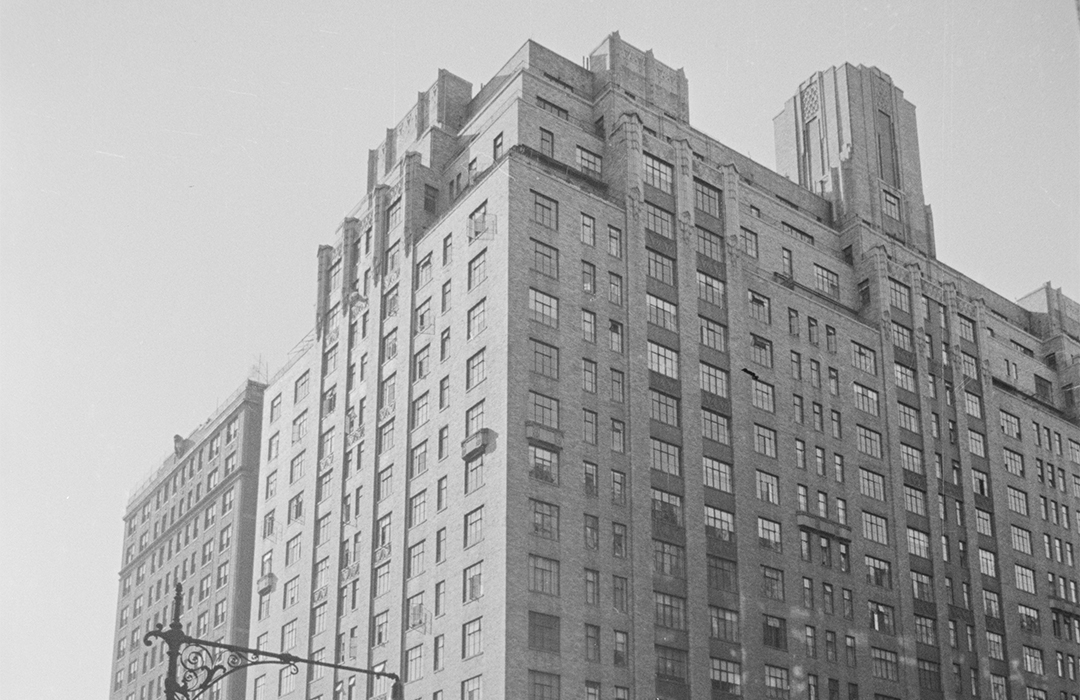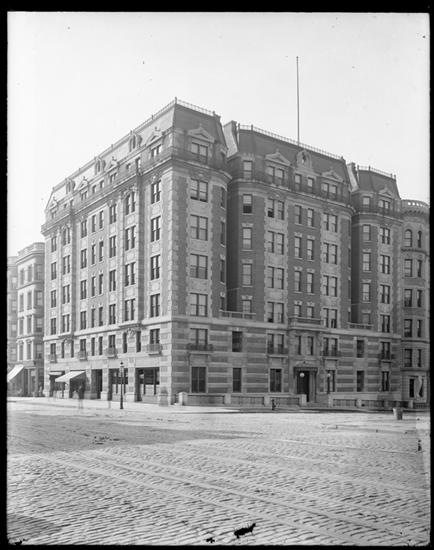
The New Amsterdam, 200 West 86th Street
by Tom Miller
The architectural firm of Schwartz & Gross would design five striking Art Deco apartment buildings on the Upper West Side in 1929. In addition to four on Central Park West—101 Central Park West, 55 Central Park West, 241 Central Park West, and 91 Central Park West—the firm designed the New Amsterdam Apartments at 200 West 86th Street on the southwest corner of Amsterdam Avenue.
The New Amsterdam Apartments sat on the site of the former St. Germaine apartment house. Completed in 1930, the 19-floor building was clad in beige brick above the row of storefronts at street level. Full height, slightly projecting brick piers on both elevations rose past the setbacks where they exhibited sculpted decorations. At their bases were slender cast stone panels that created designs like stylized Empire State Buildings. Faux balconies were decorated with crisp Art Deco designs.
Among the early residents were Jack and Mildred Rosenblatt. Jack Rosenblatt ran the Kung Chen Fur Corporation, which necessitated the couple’s living (for the most part) in China. The New Amsterdam Apartments suite was their Manhattan pied-a-terre. When Mildred became pregnant in 1932, according to Carl Rollyson and Lisa Paddock, in their Susan Sontag: The Making of an Icon, she was “nervous about giving birth overseas.” She returned to The New Amsterdam, and on January 16, 1933, the couple’s first daughter, Susan Lee was born. Jack Rosenblatt died in China in 1939. Mildred married U.S. Army Captain Nathan Sontag seven years later. Susan Sontag would go on to become a critic, novelist, essayist, and filmmaker.
Hans, who was born in Austria in 1894, was a composer and orchestrator.
Herman Mandelbaum was another early resident. Born in Kassel, Germany in 1849, he came to the United States at the age of 13. A retired wholesale tobacco merchant, his wife, the former Rosa Weil, had died in 1919 in their apartment at 1,229 Park Avenue. Seven years earlier, they had taken in their daughter, Tillie Taussig and granddaughter Ruth, when they returned to New York City on the RMS Carpathia. Having survived the sinking of the RMS Titanic, they were too traumatized to return to their apartment at 777 West End Avenue. Tillie’s husband and Ruth’s father, Emil Taussig, did not survive. Herman Mandelbaum died at the age of 83 in his apartment here on April 19, 1933.
Among the other residents in 1933 were Hans and Dora Spialek. Hans, who was born in Austria in 1894, was a composer and orchestrator. He would best be remembered for scoring the music for Rodgers and Hart musicals like On Your Toes, I Married an Angel, Babes in Arms and Pal Joey; for Cole Porter productions like The Gay Divorcee, Du Barry Was a Lady, and Anything Goes; and for Ira and George Gershwin’s Strike Up the Band. Hans Spialek would score 138 other Broadway shows in the 1930s and ‘40s. Dora Spialek was born in Russian in 1895. The operatic soprano, known on the concert stage as Dora Boshoer, appeared throughout America and in Canada.
Maximilian Nogida lived here at the time. Since 1895 he had been a copyist with the Metropolitan Museum of Art. In an interview in the New York Evening Post on November 3, 1933, he said, “You might almost say they build the museum around me. Only one wing was finished when I started here.” He recalled, “One day, long ago, I felt someone’s hand on my shoulder while I was working. I looked around and there stood J. P. Morgan, the elder, ‘Young man,’ he said, ‘you are wonderful. You ought to do originals.’”
Joseph E. Austrian also had an interesting occupation. Born in Greenwich, Connecticut in 1869, the retired manufacturer was a crossword puzzle expert and composer. He had published several crossword puzzle books and was president of the Cross-Word Puzzle Association of America. He and his wife had a country home in Greenwich.
Attorney Jerome A. Jacobs brought unfavorable press coverage to The New Amsterdam Apartments in 1936. The 48-year-old was indicted with two associates on July 21, 1936 for extortion. The Plattsburgh Daily Press reported that they extorted $1,800 from Harry Bannister, “actor and former husband of Ann Harding, screen actress.” When they attempted to extort $1,000 more, Bannister balked and notified the district attorney.
Another resident would be behind bars the following year. On January 7, 1937, The Sun reported, “The first move in a concentrated drive to smash the long-established, smoothly functioning poultry racket, was made today when the police…arrested Arthur (Tootsie) Herbert, business agent, and David Diamondstone, president of the Chicken Drivers’ Chauffeurs and Helpers Union, Local 167 on charges of embezzling $38,876.98 from the organization’s treasury.” The amount stolen would equal about $825,000 in 2024. The article added, “Herbert, alleged czar of the poultry racket for twelve years, was arrested at 7:30 A.M. today at his home, 200 West eighty-sixth street.”
Another resident would be behind bars the following year.
Later that year, on August 31, the New York Post covered the previous night’s Joe Louis-Tommy Farr heavyweight boxing match at Yankee Stadium. “World-wide interest was evidenced in last night’s fight,” said the article. In the stands were Edward Gobel, a resident of 200 West 86th Street, and his brother-in-law, Harry Perlman. The excitement of the evening took its toll on some avid boxing fans. The New York Post reported, “Five deaths throughout the country were attributed to excitement over last night’s bout.” Among them was 44-year-old Harry Perlman, who suffered a fatal heart attack.
Harry and Grace Fox lived here in the early 1940s. Fox was the manager of Calvert Distilling Corp., and Grace was a former nightclub singer and actress. Known professionally as Grace Morgan, she now hosted a weekly nationwide, five-minute radio show. On the night of December 18, 1943, the couple was sitting in the living room of their 12th-floor apartment when Grace excused herself, “saying she was ill,” according to the Wisconsin State Journal. She went to the roof of the building and jumped to her death. The article said, “Her body was discovered a short time afterward by her brother-in-law when he arrived for a visit.” Harry Fox said his wife was depressed because she could not appear on her radio show that evening because she was ill.
Michele Urvater opened her French cooking school in her apartment here in 1976. The New York Times said the “teaching space is limited to a foyer and small kitchen,” but that Urvater’s “course promises to become one of the best.” Indeed, it was still going strong as late as 1981.
When the building converted from rental to cooperative, the name was changed to The St. Germaine, harkening back to the pre-1929 building.
Tom Miller is a social historian and blogger at daytoninmanhattan.blogspot.com
Building Database
Be a part of history!
Think Local First to support the businesses at 200 West 86th Street/ 530 Amsterdam Avenue:
Meet David Roth!



